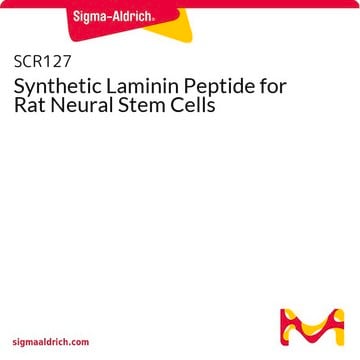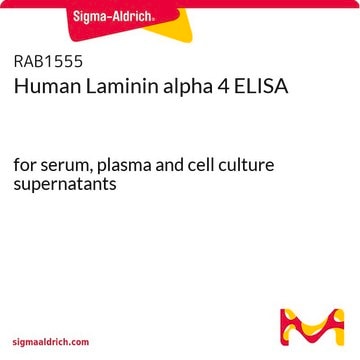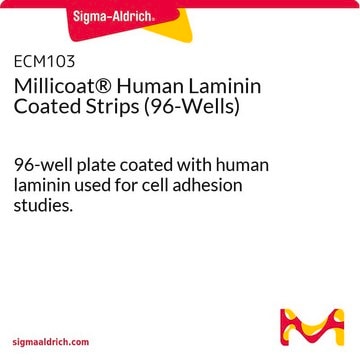L2020
Mouse Laminin
from Engelbreth-Holm-Swarm murine sarcoma basement membrane, 0.2 μm filtered, liquid, 1-2 mg/mL, suitable for cell culture
Synonim(y):
Laminin
About This Item
Polecane produkty
product name
Laminin from Engelbreth-Holm-Swarm murine sarcoma basement membrane, 1-2 mg/mL in Tris-buffered saline, 0.2 μm filtered, BioReagent, suitable for cell culture
pochodzenie biologiczne
mouse (Engelbreth-Holm-Swarm mouse sarcoma basement membrane)
Poziom jakości
linia produktu
BioReagent
Postać
aqueous solution
masa cząsteczkowa
A subunit 400 kDa
B1 subunit 210 kDa
B2 subunit 200 kDa
opakowanie
pkg of 1 mg
stężenie
1-2 mg/mL in Tris-buffered saline
metody
cell culture | mammalian: suitable
pokrycie powierzchni
1‑2 μg/cm2
zanieczyszczenia
Microbial Contamination, passes test
numer dostępu NCBI
Specyficzność wiązania
Peptide Source: Collagen
Warunki transportu
dry ice
temp. przechowywania
−20°C
informacje o genach
mouse ... Lama1(16772) , Lamb1(16777) , Lamc1(226519) , Lamc2(16782)
Szukasz podobnych produktów? Odwiedź Przewodnik dotyczący porównywania produktów
Opis ogólny
Zastosowanie
- insulin-producing cell (IPC) differentiation.
- Infection inhibition assays.
- Proliferation Assay.
Działania biochem./fizjol.
Komponenty
Przestroga
Uwaga dotycząca przygotowania
produkt powiązany
Kod klasy składowania
11 - Combustible Solids
Klasa zagrożenia wodnego (WGK)
WGK 3
Temperatura zapłonu (°F)
Not applicable
Temperatura zapłonu (°C)
Not applicable
Środki ochrony indywidualnej
Eyeshields, Gloves, type N95 (US)
Certyfikaty analizy (CoA)
Poszukaj Certyfikaty analizy (CoA), wpisując numer partii/serii produktów. Numery serii i partii można znaleźć na etykiecie produktu po słowach „seria” lub „partia”.
Masz już ten produkt?
Dokumenty związane z niedawno zakupionymi produktami zostały zamieszczone w Bibliotece dokumentów.
Klienci oglądali również te produkty
Produkty
The extracellular matrix (ECM) and its attachment factor components are discussed in this article in relation to their function in structural biology and their availability for in vitro applications.
Macierz zewnątrzkomórkowa (ECM) i jej składniki czynnika wiążącego są omówione w tym artykule w odniesieniu do ich funkcji w biologii strukturalnej i ich dostępności do zastosowań in vitro.
The extracellular matrix (ECM) is secreted by cells and surrounds them in tissues.
Frequently asked questions about neural stem cells including NSC derivation, expansion and differentiation.
Protokoły
Coating surfaces with laminin for culturing cells requires specific conditions for optimal results. Protocols for coating coverslips to culture neurospheres and general cell culture are included.
A stem cell culture protocol to generate 3D NSC models of Alzheimer’s disease using ReNcell human neural stem cell lines.
Protokół hodowli komórek macierzystych do generowania modeli 3D NSC choroby Alzheimera z wykorzystaniem linii ludzkich neuronalnych komórek macierzystych ReNcell.
Step-by-step culture protocols for neural stem cell culture including NSC isolation, expansion, differentiation and characterization.
Nasz zespół naukowców ma doświadczenie we wszystkich obszarach badań, w tym w naukach przyrodniczych, materiałoznawstwie, syntezie chemicznej, chromatografii, analityce i wielu innych dziedzinach.
Skontaktuj się z zespołem ds. pomocy technicznej













